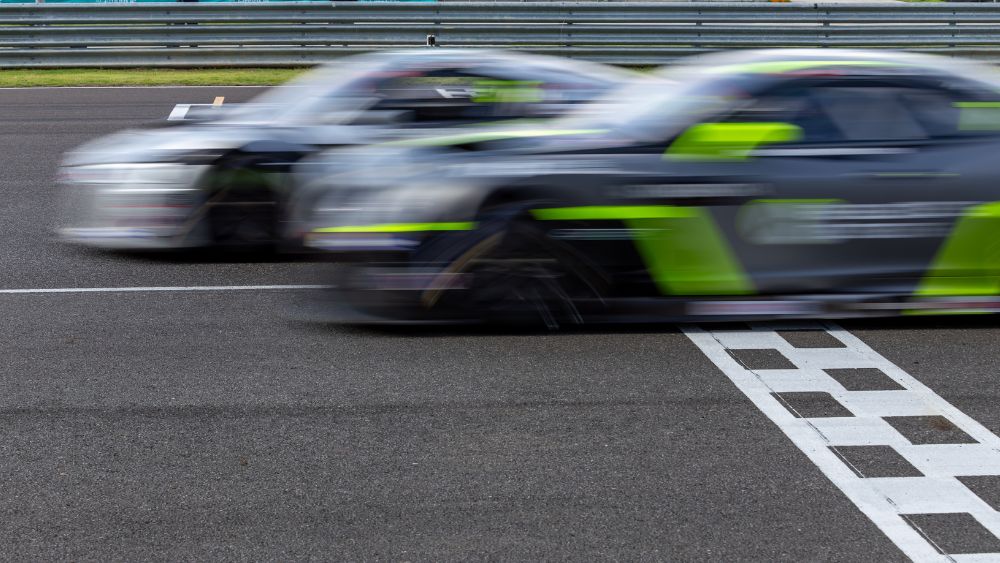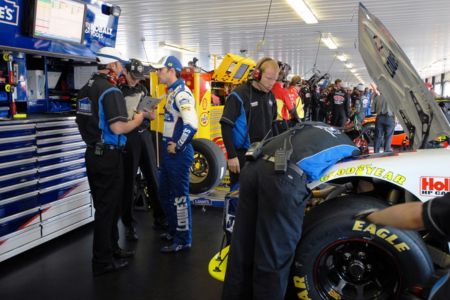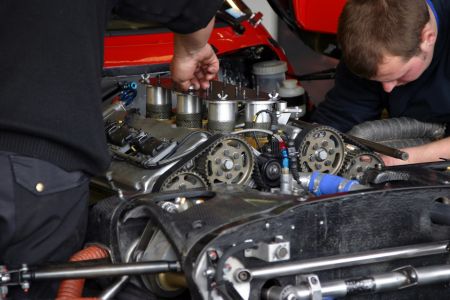
NASCAR is synonymous with high-speed racing and thrilling motorsport entertainment. While the spotlight often shines on the drivers who skillfully maneuver these powerful machines, the NASCAR industry is also home to many high-paying jobs crucial to the sport’s success. For those interested in careers beyond the racetrack, numerous opportunities exist to be part of this fast-paced world. This blog will delve into some of the top-paying NASCAR jobs that don’t involve driving a race car, exploring their roles, average yearly salaries, the education and experience required to land these highly sought-after careers, and how to secure these coveted positions.
Whether you’re eyeing a role as a NASCAR engineer, crew chief, marketing manager, or another key player, Jobs In Sports can help you find the right opportunities in this exciting field. Read on to discover how to turn your NASCAR passion into a lucrative career.
Top Paying Jobs in NASCAR
NASCAR is not just about the high-speed thrills of race day; it’s also a multifaceted industry with a range of high-paying careers that keep everything running smoothly behind the scenes. Several lucrative roles play crucial parts in the NASCAR ecosystem, from engineers’ technical precision to crew chiefs’ strategic oversight.
Below, we highlight some of the top-paying jobs in NASCAR, detailing their responsibilities, average salaries, educational requirements, and tips for securing these coveted positions. Whether you have a knack for engineering, marketing, or mechanics, a rewarding career path is waiting for you in this exciting sport.
NASCAR Engineers
Job Description
Average yearly salary: $70,000 – $120,000
NASCAR Engineers play a crucial role in the motorsport industry by focusing on designing, developing, and optimizing race cars. Their primary objective is to ensure that the vehicles perform at the highest possible level in terms of speed and safety. Here’s an overview of what the role entails:
Key Responsibilities
- Design and Development: Create and refine car components, such as the chassis, suspension, and engine parts, to enhance performance and durability. Engineers use advanced tools and software for simulations and modeling to test new designs.
- Performance Analysis: Analyze data from car testing and races to assess the performance of various components, including reviewing telemetry data to make adjustments that improve speed, handling, and overall efficiency.
- Testing and Evaluation: Perform thorough testing, such as wind tunnel and track tests, to assess the impact of design changes. Verify that the car complies with all safety standards and regulations.
- Collaboration: Work closely with drivers, crew chiefs, and other team members to align car setups with race strategies. Provide technical support during races and troubleshoot any issues that arise.
- Continuous Improvement: Stay current on technological advancements and industry trends. Apply innovative solutions and modifications informed by emerging technologies and research.
Skills and Qualifications
- Educational Background: A bachelor’s degree in mechanical engineering, automotive engineering, or a related field is typically required.
- Experience: 3-5 years of experience in automotive or motorsport engineering is preferred. Practical experience with race car development and performance tuning is highly beneficial.
- Technical Skills: Proficiency in engineering software for design and simulations, such as CAD (Computer-Aided Design) and CAE (Computer-Aided Engineering) tools. Strong analytical skills to interpret complex data.
- Problem-Solving: Excellent troubleshooting abilities to diagnose and resolve technical issues effectively.
- Communication: Strong communication skills to collaborate with team members and explain technical concepts clearly.
NASCAR Engineers are integral to a team’s success, driving innovation and ensuring that race cars perform optimally under competitive conditions.
How to Become a NASCAR Engineer
To become a NASCAR engineer, start by obtaining a relevant engineering degree. Gaining experience through internships or entry-level positions in automotive or motorsport industries can provide valuable hands-on knowledge. Networking within the motorsport community can also open doors to job opportunities.
NASCAR Crew Chief
Job Description
Average Yearly Salary: $200,000 – $1 million
A NASCAR Crew Chief plays a critical leadership role within the pit crew, overseeing all aspects of a race car’s performance during a race. This position requires a combination of strategic thinking, technical expertise, and team management abilities. Here’s a detailed overview of the role:
Key Responsibilities

- Race Strategy: Develop and implement race strategies, including determining pit stop timing, making adjustments to the car, and responding to changes in track conditions. Make real-time decisions to optimize performance and gain competitive advantages.
- Team Management: Lead and coordinate the pit crew, ensuring all members perform their tasks efficiently and effectively. Maintain clear communication and foster teamwork to ensure quick and precise pit stops.
- Car Setup and Adjustments: Oversee the preparation and setup of the race car, making necessary adjustments based on driver feedback and track conditions. Ensure the car is race-ready and compliant with all technical specifications.
- Problem-Solving: Quickly address and resolve any mechanical or performance issues that arise during the race. Adapt strategies and make adjustments to counteract unexpected challenges or changes in race dynamics.
- Collaboration: Work closely with engineers, drivers, and other team members to align on car setups, race strategies, and performance goals. Ensure seamless coordination and execution of race plans.
Skills and Qualifications
- Educational Background: A bachelor’s degree in mechanical engineering, automotive technology, or a similar field is typically preferred.
- Experience: Extensive experience in racing and pit crew roles is essential. Proven leadership abilities and a successful history of managing pit stops and race strategies are also essential.
- Technical Skills: A solid understanding of race car mechanics and performance tuning and the capability to make swift, well-informed decisions under pressure.
- Leadership: Proven ability to lead and motivate a team, manage tasks efficiently, and maintain clear communication during high-stress situations.
How to Become a NASCAR Crew Chief
To become a NASCAR Crew Chief, start by gaining extensive experience in various pit crew roles and demonstrating strong performance and leadership abilities. Build a reputation for strategic thinking and successful race management. Networking within the racing community and showcasing your skills and achievements can help you advance to a Crew Chief position.
Marketing Manager
Job Description
Average Yearly Salary: $60,000 – $130,000.
A NASCAR Marketing Manager oversees the motorsport industry’s sponsorships, promotions, and public relations efforts. This role involves developing and executing marketing strategies that enhance NASCAR teams’ and sponsors’ visibility and reputation. Here’s a detailed overview of the role:
Key Responsibilities
- Marketing Strategy: Develop and implement comprehensive marketing plans to promote the NASCAR team, drivers, and sponsors. This includes creating advertising campaigns, managing media relations, and planning promotional events.
- Sponsorship Management: Negotiate and manage sponsorship deals, ensuring that sponsor expectations are met and that the partnership provides value to both parties. Coordinate with sponsors to create mutually beneficial promotional activities.
- Public Relations: Handle public relations efforts to maintain a positive image of the team and its sponsors. Manage media inquiries, craft press releases, and organize press conferences and media events.
- Brand Development: Work on developing and maintaining the brand identity of the NASCAR team. Ensure consistent messaging across all marketing materials and platforms to build and strengthen brand recognition.
- Market Analysis: Analyze market trends and audience insights to tailor marketing strategies effectively. Use data to assess the effectiveness of marketing campaigns and make informed decisions.
Skills and Qualifications
- Educational Background: A bachelor’s degree in marketing, business, or a related field is typically required.
- Experience: 5+ years of marketing experience, preferably in sports or motorsports. Proven experience in managing marketing campaigns and sponsorships is highly valuable.
- Technical Skills: Proficiency in marketing tools and software, including social media platforms, analytics tools, and CRM systems. Strong understanding of digital marketing strategies and trends.
- Communication: Excellent written and verbal communication skills for crafting compelling marketing materials and interacting with sponsors, media, and the public.
How to Become a Marketing Manager in NASCAR
Building a robust portfolio of marketing campaigns and networking within the industry can help secure a position as a Marketing Manager in NASCAR. Experience with sports or motorsports marketing will be particularly advantageous.
Race Car Mechanic
Job Description
Average Yearly Salary: $45,000 – $80,000
A Race Car Mechanic plays a crucial role in maintaining and repairing the high-performance vehicles used in NASCAR. This position involves hands-on work with various car components to ensure they function correctly and meet the rigorous demands of racing. Here’s a detailed overview of the role:
Key Responsibilities

- Maintenance and Repair: Perform routine maintenance and repairs on race cars, including engine work, suspension adjustments, and brake system overhauls. Ensure all components are in optimal condition for peak performance during races.
- Component Installation: Install and replace parts such as engines, transmissions, and suspension components. Follow precise specifications and procedures to ensure proper fit and functionality.
- Diagnostics: Use diagnostic tools and techniques to identify and troubleshoot mechanical issues. Perform tests and inspections to assess the condition of car parts and systems.
- Preparation for Races: Prepare race cars for competition by conducting thorough inspections and making necessary adjustments. Ensure that all systems are fully operational and compliant with NASCAR regulations.
- Collaboration: Work closely with engineers, crew chiefs, and other team members to coordinate repairs and maintenance. Communicate effectively to address any issues or required adjustments based on driver feedback and performance data.
Skills and Qualifications
- Educational Background: Vocational training or an associate degree in automotive technology is typically required. Specialized training in race car mechanics is highly beneficial.
- Experience: 2-4 years of experience in automotive repair, with a preference for experience in racing or high-performance vehicles. Proven hands-on skills in repairing and maintaining race cars.
- Technical Skills: Strong understanding of automotive systems and repair techniques. Proficiency with diagnostic tools and equipment used in race car maintenance.
- Attention to Detail: Ability to work meticulously and follow precise procedures to ensure that race cars are in top condition. Excellent problem-solving skills to address and resolve mechanical issues effectively.
How to Become a Race Car Mechanic in NASCAR
To become a Race Car Mechanic, start by obtaining relevant vocational training or an associate degree in automotive technology. Gain hands-on experience through volunteer work, internships, or entry-level positions with racing teams or automotive shops. Building a strong understanding of race car systems and developing practical skills are essential.
Aerodynamicist
Job Description
Average yearly salary: $70,000 – $120,000
An Aerodynamicist in NASCAR focuses on optimizing the aerodynamics of race cars to improve their performance on the track. This role involves designing and testing aerodynamic components to reduce drag and enhance downforce, which is critical for speed and handling. Here’s a detailed overview of the role:
Key Responsibilities
- Aerodynamic Design: Design and develop aerodynamic components such as spoilers, wings, and diffusers to enhance the car’s performance. Use advanced software and tools to create models and simulations of aerodynamic features.
- Testing and Analysis: Conduct wind tunnel tests and track simulations to evaluate the effectiveness of aerodynamic designs. Analyze test data to make informed decisions about modifications and improvements.
- Performance Optimization: Work closely with engineers and drivers to integrate aerodynamic solutions into the race car. Adjust designs based on performance feedback and track conditions to ensure optimal handling and speed.
- Research and Development: Stay updated with the latest aerodynamic technology and techniques advancements. Apply new research findings to enhance car performance and maintain a competitive edge.
- Collaboration: Collaborate with the engineering team to ensure that aerodynamic components meet technical specifications and regulations. Provide insights and recommendations based on aerodynamic analysis and testing.
Skills and Qualifications
- Educational Background: A bachelor’s degree in aerodynamics, aerospace engineering, mechanical engineering, or a related field is required. Advanced degrees or specialized certifications in aerodynamics can be advantageous.
- Experience: 3-5 years of experience in aerodynamics or motorsport engineering, with a focus on high-performance vehicles. Practical experience with aerodynamic testing and simulations is essential.
- Technical Skills: Proficiency in aerodynamic simulation software and tools. Strong analytical skills to interpret data and make design adjustments.
- Attention to Detail: Ability to work meticulously on complex aerodynamic designs and ensure that all components are optimized for performance. Excellent problem-solving skills to address aerodynamic challenges effectively.
How to Become a NASCAR Aerodynamicist
To pursue a career as an Aerodynamicist, start by obtaining a relevant degree in aerodynamics, aerospace engineering, or mechanical engineering. Gain experience through internships or entry-level positions focused on aerodynamic design and testing. Develop expertise with aerodynamic simulation tools and stay informed about industry advancements. Networking within the motorsport community and showcasing your aerodynamic design and analysis skills can help you secure a role in this specialized field.
How to Get a Top Paying NASCAR Job
Securing a high-paying job in NASCAR requires a combination of targeted education, relevant experience, strategic networking, and a proactive job search. Here’s a step-by-step guide to help you navigate the path to landing a top-paying position in the exciting world of NASCAR.
1. Acquire Relevant Education and Skills
Begin by obtaining the necessary educational qualifications for your desired role. A bachelor’s degree in mechanical engineering, automotive engineering, or aerodynamics is crucial for technical positions like engineers or aerodynamicists. A degree in marketing, business, or a related field is essential for roles like marketing managers. Specialized certifications or advanced degrees can further enhance your qualifications and make you a more attractive candidate.
2. Gain Hands-On Experience
Experience is key in the NASCAR industry. Seek internships or entry-level positions to gain practical knowledge and skills. Working with automotive companies, racing teams, or motorsport organizations can provide valuable insights into the industry and build your resume. Hands-on experience with race car systems, repairs, and performance tuning is critical for technical roles. Experience with sports or motorsports marketing is highly valuable for positions like marketing managers.
3. Build a Strong Portfolio
Develop a portfolio that showcases your skills and accomplishments. For engineers and aerodynamicists, include examples of successful projects, designs, or performance improvements. For marketing managers, highlight campaigns you’ve managed, sponsorships secured, and public relations efforts. A strong portfolio demonstrates your expertise and achievements to potential employers.
4. Network Within the Industry
Networking is a powerful tool for finding job opportunities and advancing your career in NASCAR. Attend industry events, conferences, and seminars to connect with professionals. Join professional organizations such as the Society of Automotive Engineers (SAE) or marketing associations relevant to motorsports. Online forums and social media platforms can also provide networking opportunities and keep you informed about industry trends and job openings.
5. Stay Updated on Industry Trends
The NASCAR industry is constantly evolving with new technologies and trends. Stay up-to-date on the latest in automotive technology, marketing strategies, and racing regulations. Follow industry news and participate in continuing education to keep your skills and knowledge up-to-date.
6. Utilize Job Boards and Career Resources
Using job boards and career resources can help you find job openings and connect with potential employers. Websites like Jobs In Sports offer a wealth of job listings specifically tailored to the sports and NASCAR industries. Regularly check these platforms for new opportunities and set up job alerts to stay updated on the latest openings.
7. Prepare for the Application Process
When applying for top-paying NASCAR jobs, update your resume and cover letter to focus on your relevant skills, experience, and achievements. Be prepared for the application process, which may include technical assessments, interviews, and demonstrations of your expertise. Showcasing your passion and understanding of the industry will set you apart from other candidates.
8. Leverage Your Network
Once you’ve made connections within the industry, leverage your network to learn about job opportunities and gain recommendations. Connect with your contacts, let them know about your job search, and ask for introductions and references from hiring managers. Networking can provide insights and opportunities, increasing your chances of landing an interview for a top-paying NASCAR position.
Following these steps can enhance your chances of securing a top paying NASCAR job. Whether you’re aiming for a role as an engineer, crew chief, marketing manager, or any other position, a strategic approach to education, experience, and networking will help you achieve your career goals.
Ready to Chase Your NASCAR Dream? Get Started!
Embarking on a career in NASCAR offers the exciting opportunity to be a part of one of the most dynamic and thrilling sports industries. Whether you’re aiming for a role as a NASCAR engineer, crew chief, marketing manager, or another high-paying position, the key to success lies in combining the right education, hands-on experience, and strategic networking.
To get started, focus on acquiring relevant qualifications, gaining relevant experience, and building your portfolio. Networking within the industry and staying up-to-date on trends will also help you stand out. Utilize job boards and career resources like Jobs In Sports to find and apply for job openings that align with your career goals.
Pursuing a career in NASCAR is both challenging and rewarding, and with the right approach, you can achieve your dream job in this high-octane field. Don’t let the opportunity slip away—take the first step towards your NASCAR career today!
Ready to get started? Explore job openings and find your next opportunity with Jobs In Sports. Subscribe now to stay updated on the latest NASCAR career opportunities and move your career into the fast lane!





